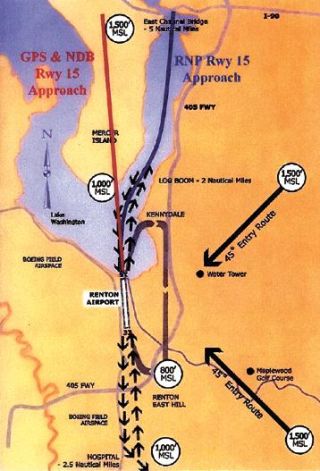New GPS technology would direct planes
By J. Jacob Edel
Mercer Island Reporter
Technology used to protect the nation’s capitol against terrorism may be the solution to protect Mercer Islanders from noise pollution and jet crashes. That is if the FAA approves a new “curved” approach over the East Channel as it has begun to do at other airports in the U.S.
Beginning in September 2005, Alaska Airlines flights became the first to use Required Navigation Performance (RNP) approaches to land at Ronald Reagan Washington Airport in D.C. The Alaska aircraft equipped with RNP technology heading into Reagan follow a path above the Potomac River and avoid the restricted airspace above the White House, Capitol Building and numerous federal buildings.
RNP, essentially allows the approaching jets to weave around the prohibited airspace as if it were flying through a hazardous mountain range. “Curved” approaches, such as the one proposed over the East Channel, are already in use to access terrain-challenged airports in Alaska as well.
A similar curved approach at Renton is what city and airport officials from Renton want here. If the FAA approved the approach and moved jet traffic approaching the airport over the East Channel rather than above the Island, residents would be spared from overhead jet traffic as aircraft weave their way through the channel before landing.
In order to work, RNP approaches use a combination of onboard navigation technology and the Global Positioning System, or GPS, satellite networks instead of ground-based navigational aids. Renton officials have said that the new aircraft it hopes the proposed corporate jet center would bring in will be equipped with RNP technology. The new RNP technology would eliminate the need for the above Island approach because the computer-aided landings can be done with less visibility and in worse weather, according to an FAA press release on the subject issued last November. Currently, pilots may choose to approach their landing over the East Channel if the weather is good or they can fly over the middle of the Island. If visibility or the weather is poor then the FAA requires aircraft to fly over the center of the Island.
Renton officials have publicly asked the Mercer Island City Council and Island residents to help them persuade the FAA to change that flight path. Renton has yet to file the official paper work, however, and the FAA has not begun evaluating a submitted form 7460, or the Notice of Proposed Construction or Alteration, said Allen Kenitzer, a spokesman for the FAA Northwest Mountain & Alaska Regions.
According to Kenitzer the FAA does not think Renton Airport is over-used or under-used, nor will it change the airport’s role as a reliever for SeaTac and Boeing Field.
“Renton serves as a reliever airport for SeaTac and while the current runway situation is acceptable for use by some jets,” Kenitzer said, “we are concerned that it stay open to all types and classes of aircraft and abide by and meets its grant obligations.”
Renton Airport Manager Ryan Zulauf said the city is going to complete a noise study and is considering conducting an environmental impact study before submitting the proposal and getting the FAA formally involved.
Kenitzer said that form 7460 is an application process that notifies the organization of an airport’s intentions before going through an “airspace process” that looks at the proposal from an airspace perspective. That means the FAA will look at Renton’s expansion plans and decide if RNP technology and will be practical, safer and decrease the impacts the airport leaves on surrounding communities. Kenitzer also said that any details about the project cannot be answered until the form has been submitted.
The press release from last November, however, states the FAA plans to shift its operations predominately to RNP between 2011 and 2015 and it has already approved RNP technology for some airports in the United States. In 2006, the FAA authorized a total of 37 RNP procedures at 17 airports. It also plans to publish at least 25 more RNP approach procedures in 2007. Other nations, such as China and New Zealand, are using RNP as well.


